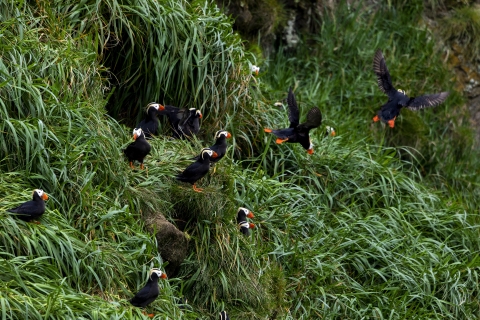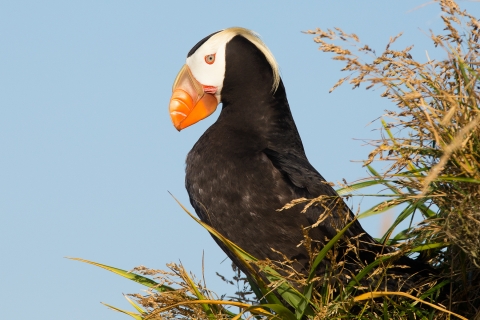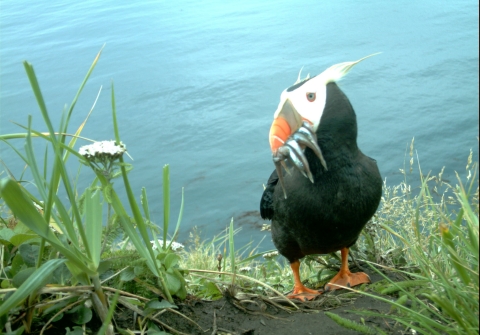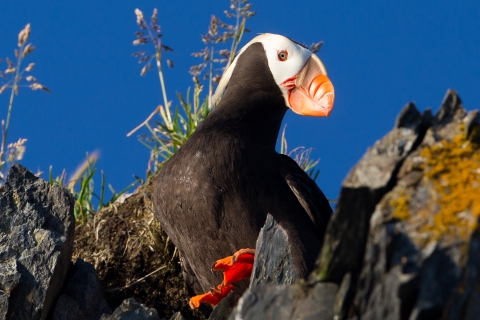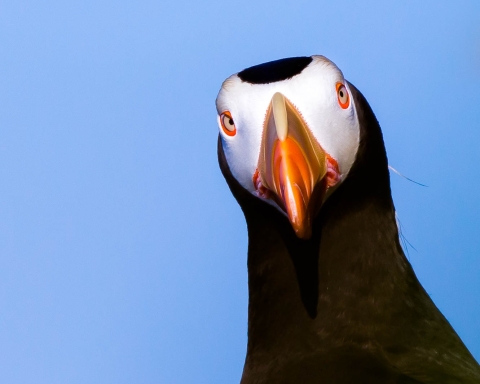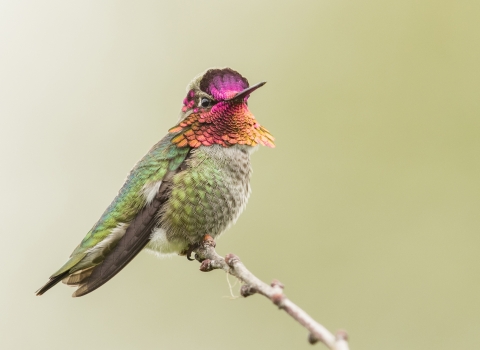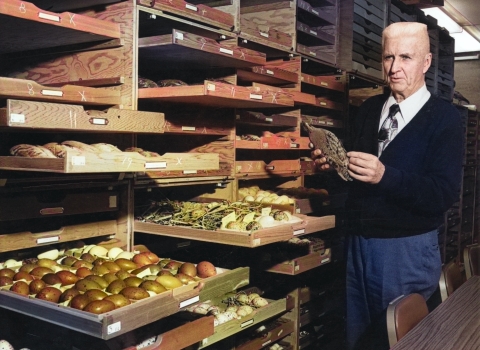Have you ever peeped a tufted puffin? Chances are, you (lucky ducky) saw them during the summer breeding season: bright orange beaks, long golden feather head plumes, and a sharp white and black eye mask with red eyeliner that has earned them the name "clown of the sea." They might have been perched on steep grassy banks near their burrows, or bobbing nearby in groups on the ocean.
Tufted puffins are seabirds in the auk family that, in North America, range from the coast of California to the northern icy waters off the coast of Alaska. There are an estimated 3 million tufted puffins worldwide, about 2.5 million of which are in North America - and about 96% of those breed in Alaska.
They actually spend most of their year out on the open ocean - sometimes more than a hundred miles offshore - and only come to land for a few months to breed, nest, and rear chicks (called pufflings!). Tufted puffins breed at several national wildlife refuges in Alaska, including Alaska Maritime, Kodiak, Izembek, Alaska Peninsula/Becharof, and Togiak refuges.
Burrows can be up to 7 feet long, and puffins use the claws and webbed feet to dig and then line their nest with grass, seaweed, or feathers. The female lays a single egg, which both parents tend during incubation and after the chick hatches.
During their temporary time on land, puffins stay well connected with the ocean through their daily seafood diet of mostly small, plump silver morsels, known as forage fish: capelin, sand lance, mackerel, and Pacific herring.
Seafood samplers
Tufted puffins can also give humans a window into the health of the marine ecosystem, thanks to their smorgasbord approach to the nearshore areas around their burrows. They are "samplers" of the sea, generalist hunters that will grab a selection of the prey available in an area. Scientists can then collect diet samples from the puffins as they return to burrows to feed their chicks during July and August. And when they deploy and retrieve tracking devices to learn where puffins spent the winter months, scientists also collect feather samples from adult puffins and eggshells from burrows where chicks have hatched. The chemical makeup of feathers and eggshell membranes also provide a window into puffin diet.
DYK? Neato things about tufted puffin dining behavior
- Adults eat their prey underwater! When you see an adult with fish in its bill on the surface or in flight, they are delivering a take-out meal to chicks in a burrow.
- In pursuit of prey, puffins can dive and "fly" underwater up to a depth of 200 feet, flapping their wings for propulsion and using their orange webbed feet to steer.
- They have denticles (a type of serrated tooth) on their beaks, a locking tongue, and a large jaw, that in combination function like a vice grip that helps them grab and hold lots of small fish crosswise - as many as 20 at a time!
- Adults have a more diverse diet than their kids! In addition to small fish, they also dine on mollusks, cephalopods, and crustaceans - including squids, octopus, crabs, and jellyfish.
Using cameras to photograph fish deliveries to burrows is one way of sampling the diet fed to pufflings. Another involves laying a screen across the burrow entrance to intercept the delivery.
Sentinels of the sea
Biologists have monitored tufted puffins at their breeding sites in Alaska for several decades, recording population trends over time through land- and sea-based surveys.
At five of the eight long-term seabird monitoring camps on remote islands of Alaska Maritime National Wildlife Refuge, bio technicians spend their summer conducting surveys that include tufted puffin counts, chick monitoring, and diet sampling. Kodiak National Wildlife Refuge staff maintained a long-term dataset stretching back to 1975, and surveyed tufted puffin and other seabird populations at colony sites in the Kodiak Archipelago from the research vessel, the Ursa Major II through 2023.
Seabird diet samples collected on Buldir Island, Alaska Maritime National Wildlife Refuge.
Data from diet samples can tell us a lot about what is going on in the ocean near these islands - so much, in fact, that we partner with the National Marine Fishery Service/National Oceanic and Atmospheric Administration (NMFS/NOAA) to contribute to an annual snapshot report of ocean health.
Sentinel of the sea: a tufted puffin swims at the surface of the North Pacific Ocean near Kodiak Island.
Each fall, NOAA releases Alaska Ecosystem Status Reports for three Large Marine Ecosystem (LME) areas of Alaska: the Gulf of Alaska, Aleutian Islands, and the Bering Sea. They provide stronger links between Alaska ecosystem research and fishery management, studying the whole ecosystem to manage our diverse marine resources more comprehensively with regional fishery management councils and other partners. These reports also help spur new understanding of the connections between ecosystem components by bringing together the results of diverse research efforts. The reports are then included in the annual Fisheries Management Plans that provide harvest parameters for commercial fisheries.
Watch: a video from NOAA about the many agencies, organizations, and communities that collaborate for the ecosystem reports.
Because tufted puffins take a little bit of this and a little bit of that from the seafood buffet in their breeding areas, their diet information can be particularly helpful to inform sustainable fisheries management: fish prey on some of the same species as tufted puffins. Seabirds like tufted puffins can also give us an indication of overall ocean health - including the impact of unusual incidents like the recent marine heat waves.
A tufted puffin at a colony in the Gulf of Alaska near Kodiak Island. Note the claws on their toes, useful for digging burrows that may go seven feet deep!
As tufted puffin numbers at colonies along the Washington, Oregon, and California coasts have gone through steep declines, many colonies in northern and western coastal Alaska have remained stable. However, we have noticed fewer puffins at some colonies in the Gulf of Alaska, the large marine ecosystem area in the North Pacific Ocean that hosts about 36% of the breeding puffins in all of North America.
We don't have all the answers yet about what may be impacting puffins, but biologists have become even more interested in what we can learn from their time on saltwater. Since 2022, Kodiak National Wildlife Refuge has collaborated with Oregon State University Student Katie Stoner on work that will help us understand what puffins eat and where puffins go during their winter months at sea. This project will analyze stable isotope signatures in feather tissue and eggshell membranes, which reflect adult diet during feather growth and egg formation. Stay tuned for insights from this project!
New pieces of a seasonal puzzle: the winter sea
Tufted puffins winter offshore in the North Pacific Ocean. Their historical wintering range includes an almost 4.5 million square mile area of water. Looking for a puffin in the winter can be like trying to find a breadcrumb on a beach… But what if you could map their marine movements?
Read more to find out how two Alaska refuges are taking on this challenge:
Puzzling about puffins
Well hello there. This tufted puffin might be able to give us new clues about what its ocean life is like. Stay tuned for more!
---
In 2014, the tufted puffin was petitioned for listing under the Endangered Species Act (ESA), due to dramatic declines observed in the southern portion of its range (i.e., at colonies in the contiguous U.S. and Japan). In 2020, the species was found not warranted for listing (85 FR 78029), but concern remains regarding status of the species in some parts of its range.
The National Wildlife Refuge Program, Migratory Bird Program, and the Ecological Services Program in Alaska are working with partners to monitor and learn more about tufted puffins.


